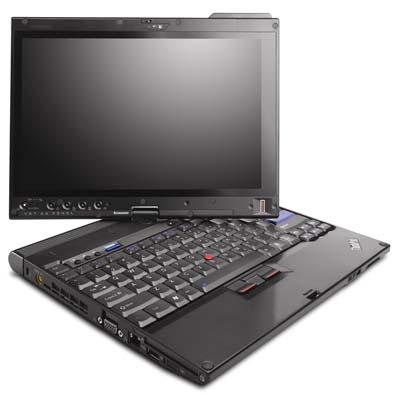The original IBM ThinkPad, all the way back in 1992 or so, was a pen computer, and a tablet at that. Consumer tastes dictated a switch to a notebook convertible format, and pen computing fans may remember the ThinkPad 360PE and 750P. For a good while there were no IBM Tablet PCs at all, but when the ThinkPad line became part of Lenovo, that changed again.

The Lenovo X200t Tablet PC was introduced on September 22, 2008 as a complement and likely replacement for the company's X61 Tablet PC. It wasn't that the X61 needed replacement, but technology moves on, and so between a need to update to Intel's Centrino 2 technology and a general migration to wide-format displays, Lenovo made the step. And added a number of other features in the process.
Intel's Centrino, of course, is not a chip but a combination of various Intel chip technologies, including CPU, chipsets and network circuitry. Since Intel's marketing convinced the public that Centrino is essentially a brand, Intel's introduction of Centrino 2 earlier in 2008 practically mandated that manufacturers issue new versions of their notebooks, lest they be considered obsolete. Nothing inherently wrong with that, though sometimes good technology gets left behind in the process.
As is, the X200t comes with all the Centrino 2 goodies, like second gen Core 2 Duo chips, a new graphics chipset, and the WiFi Link 5100/5300 miniPCIe card that can be extended to support WiMAX. Front side bus speeds are higher, supported by speedy PC3 memory. Disk technology also has not stood still, and so you can now get higher capacity disks both at 5400 rpm and 7200 rpm speeds (and some use Intel Turbo Memory). Further, with solid state disks becoming affordable, you can order the X200t with a 64 or 128GB SSD.
One example of good product planning is that those who need maximum battery life can now specify their X200t with Intel's ultra-low voltage Core 2 Duo SU9300 processor that runs at 1.2 GHz and has a thermal design power of just 10 watts. The X200t is also available with a speedier 1.86 GHz low-voltage Core 2 Duo SL9400 that has a thermal design power of 17 watts. The X61 predecessor also had processor choices, but their power consumption and thus battery life was pretty close.
A big change happened in the display area (and thus overall dimensions of the machine). While the displays still measure 12.1 inches diagnonally, the aspect ratio has changed from the X61 traditional 4:3 format to the "wide" 16:10 format. The X61 offered a standard XGA (1024 x 768 pixel) version and a high resolution SXGA+ (1400 x 1050 pixel) version. The displays available with the new machine are all WXGA (1280 x 800 pixel) resolution and have electromagnetic digitizers. You can get a standard indoor display with CCFL backlight, a superbright one (285 nits) for indoor/outdoor and an LED backlight, and one with a touch screen in addition to the digitizer and a LED backlight. However, there is no high resolution version. We miss that.
The X200t remains an exceedingly attractive machine. It is a notebook convertible that can be used as a standard laptop, as a slate, or anything inbetween. And you can now rotate the display in both directions as opposed to just clockwise. The X61 is also a compact and handy machine that weighs just 3.5 pounds with the standard 4-cell battery, and a bit more with an extended battery that boosts battery life to over ten hours.
One flaw in the design remains. We've come to expect an internal optical drive even in an ultra-portable like the X200. Panasonic and others have shown that it can be done. As is, if you need an optical drive it's either an external plug-in drive or Lenovo's ThinkPad X200 UltraBase. The slot situation has changed, with the base machine having a 3-in-1 card reader but no modem. Ten bucks extra buys you a 5-in-1 card reader that also includes the modem.
On the wireless side, the sturdy X200t comes with WWLAN (AT&T and Verizon available) that includes GPS, Intel's latest Centrino 2 WiFi wireless modules, Bluetooth, and wireless USB over ultra-wideband (UWB). WiMAX will become available later.
Else, the X200 has lots to offer. There's a PC Card/ExpressCard slot, a multi-card reader, stereo speakers with more volume, dual microphones (think VoIP), a fingerprint reader, three USB 2.0 ports, Bluetooth, WiFi, and standard embedded WWAN (which you need to activate with a telco, of course). And who doesn't love that sleek ThinkPad design that's unsurpassed after all these years?
Update February 2010: Over time, Lenovo tweaked the specs of the X200t a bit and also lowered the price. And on February 23, 2010, the company announced the X201 model, an updated version of the X200 with an Intel Core i7 processor. Lenovo claims weight as low as under 2.5 pounds and battery life as long as 11 hours (obviously not in the same unit).
Update May 2013: The X200 is still listed on the Lenovo website, but is no longer available directly from Lenovo. Retailers or resellers may still offer the product.



